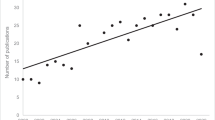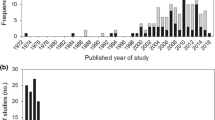Abstract
In Europe, invasive alien mammals are often controlled by voluntary hunters. However, no research investigated if control operations could be entirely performed by volunteers, nor how to maximize their recruitment. By using the Eastern cottontail (Sylvilagus floridanus) in Central Italy as a case study, we carried out a factorial survey over a sample of hunters (n = 134), exploring which attributes influenced their hypothetical participation to control programs for cottontails. Hunters were more willing to engage in control schemes if these included shooting sessions, not trapping. Moreover, they would have been more prone to control cottontails if they had received evidence of cottontail impacts over native wildlife or local crops. The geographical scale of the management plan and its goals and required efforts did not have any effect over the evaluation of management scenarios. As many European control schemes for invasive alien mammals are carried out in contexts where shooting is unfeasible, like urbanized neighborhoods, our findings show that agencies cannot entirely rely on volunteers and they should complement their limitations with full-time staff. Moreover, if wildlife agencies want to recruit volunteers, they should provide adequate information about the environmental and social impacts of invasive alien mammals.

Similar content being viewed by others
References
Auspurg K, Hinz T (2014) Factorial survey experiments, In: Series: quantitative applications in the social sciences, vol 175. Thousand Oaks, Sage Publications
Barrios-Garcia MN, Ballari SA (2012) Impact of wild boar (Sus scrofa) in its introduced and native range: a review. Biol Invasions 14:2283–2300
Bartoń K (2013) MuMIn: Multi-model inference. R package version 1.9. 13. https://cran.r-project.org/web/packages/MuMIn/MuMIn.pdf
Bates D, Maechler M, Bolker B, Walker S (2014) lme4: Linear mixed-effects models using Eigen and S4. R package version, 1(7). https://cran.r-project.org/web/packages/lme4/lme4.pdf
Bertolino S, Viterbi R (2010) Long-term cost-effectiveness of coypu (Myocastor coypus) control in piedmont (Italy). Biol Invasions 12:2549–2558
Bertolino S, Cordero di Montezemolo N, Perrone A (2011a) Daytime habitat selection by introduced eastern cottontail (Sylvilagus floridanus) and native European hare (Lepus europaeus) in northern Italy. Zool Sci 28:414–419
Bertolino S, Perrone A, Gola L, Viterbi R (2011b) Population density and habitat use of introduced eastern cottontail (Sylvilagus floridanus) in comparison with the native European hare (Lepus europaeus). Zool Stud 50:315–326
Bertolino S, Cordero di Montezemolo N, Perrone A (2013) Habitat use of coexisting introduced eastern cottontail and native European hare. Mamm Biol 78:235–240
Capizzi D, Bertolino S, Mortelliti A (2014) Rating the rat: global patterns and research priorities in impacts and management of rodent pests. Mammal Rev 44:148–162
Cerri J, Ferretti M, Tricarico E (2016) Are you aware of what you are doing? Asking Italian hunters about an invasive alien species they are introducing. J Nat Conserv 34:15–23
Cerri J, Ferretti M, Bertolino S (2017) Rabbits killing hares: an invasive mammal modifies native predator–prey dynamics. Anim Conserv 20:511–519. https://doi.org/10.1111/acv.12343
Courchamp F, Fournier A, Bellard C, Bertelsmeier C, Bonnaud E, Jeschke JM, Russell JC (2017) Invasion biology: specific problems and possible solutions. Trends Ecol Evol 32:13–22
Cowan P, Warburton B (2011) Animal welfare and ethical issues in island pest eradication. In: Veitch CR, Cloud MN, Towns DR (eds) Island invasives: eradication and management, in Proceedings of the international conference on Island invasives. IUCN, Gland and Auckland, pp 418–421
DiTomaso JM, Van Steenwyk RA, Nowierski RM, Vollmer JL, Lane E, Chilton E, Burch PL et al (2017) Enhancing the effectiveness of biological control programs of invasive species through a more comprehensive pest management approach. Pest Manag Sci 73:9–13
Dubois S, Fenwick N, Ryan EA, Baker L, Baker SE, Beausoleil NJ, Carter S, Cartwright B, Costa F, Draper C, Griffin J, Grogan A, Howald G, Jones B, Littin KE, Lombard AT, Mellor DJ, Ramp D, Schuppli CA, Fraser D (2017) International consensus principles for ethical wildlife control. Conserv Biol 31:753–760. https://doi.org/10.1111/cobi.12896
Dülmer H (2007) Experimental plans in factorial surveys: random or quota design? Sociol Methods Res 35:382–409
Dülmer H (2016) The factorial survey: design selection and its impact on reliability and internal validity. Sociol Methods Res 45:304–347
Eggleston JE, Rixecker SS, Hickling GJ (2003) The role of ethics in the management of New Zealand's wild mammals. N Z J Zool 30:361–376
Estévez RA, Anderson CB, Pizarro JC, Burgman MA (2015) Clarifying values, risk perceptions, and attitudes to resolve or avoid social conflicts in invasive species management. Conserv Biol 29(1):19–30
Ford-Thompson AE, Snell C, Saunders G, White PC (2012) Stakeholder participation in management of invasive vertebrates. Conserv Biol 26:345–356
García-Llorente M, Martín-López B, González JA, Alcorlo P, Montes C (2008) Social perceptions of the impacts and benefits of invasive alien species: implications for management. Biol Conserv 141:2969–2983
Gurnell J, Lurz P, Bertoldi W (2014) The changing patterns in the distribution of red and grey squirrels in the North of England and Scotland between 1991 and 2010 based on volunteer surveys. Hystrix 25:83–89
Hartig F (2016) DHARMa: residual diagnostics for hierarchical (multi-level/mixed) regression models. R package version 0.1. 0. https://cran.r-project.org/web/packages/DHARMa/DHARMa.pdf
Holmes ND, Campbell KJ, Keitt BS, Griffiths R, Beek J, Donlan CJ, Broome KG (2015) Reporting costs for invasive vertebrate eradications. Biol Invasions 17:2913–2925
Hox JJ, Moerbeek M, Van de Schoot R (2010) Multilevel analysis: techniques and applications. Routledge, Abingdon-on-Thames
Leung B, Lodge DM, Finnoff D, Shogren JF, Lewis MA, Lamberti G (2002) An ounce of prevention or a pound of cure: bioeconomic risk analysis of invasive species. Proc R Soc Lond B Biol Sci 269:2407–2413
Liordos V, Kontsiotis VJ, Georgari M, Baltzi K, Baltzi I (2017) Public acceptance of management methods under different human–wildlife conflict scenarios. Sci Total Environ 579:685–693
Littin KE, Mellor DJ, Warburton B, Eason CT (2004) Animal welfare and ethical issues relevant to the humane control of vertebrate pests. N Z Vet J 52:1–10
Massei G, Kindberg J, Licoppe A, Gačić D, Šprem N, Kamler J, Baubet E, Hohmann U, Monaco A, Ozoliņš J, Cellina S, Podgórski T, Fonseca C, Markov N, Pokorny B, Rosell C, Náhlik A (2015) Wild boar populations up, numbers of hunters down? A review of trends and implications for Europe. Pest Manag Sci 71:492–500
McNeely JA (2001) The great reshuffling: human dimensions of invasive alien species, ed. McNeely JA, vi + 242 pp. IUCN, Gland and Cambridge
Nakagawa S, Schielzeth H (2013) A general and simple method for obtaining R2 from generalized linear mixed-effects models. Methods Ecol Evol 4:133–142
Nimmo DG, Miller KK (2007) Ecological and human dimensions of management of feral horses in Australia: a review. Wildlife Res 34:408–417
Owens B (2017) The big cull. Nature 541:148–150
Parker H, Nummi P, Hartman G, Rosell F (2012) Invasive North American beaver Castor canadensis in Eurasia: a review of potential consequences and a strategy for eradication. Wildlife Biol 18:354–365
Parkes JP, Panetta FD (2009) Eradication of invasive species: progress and emerging issues in the 21st century. In: Clout MN, Williams PA (ed) Invasive species management. A handbook of principles and techniques. Oxford University Press, Oxford, pp 47–60
Parkes JP, Nugent , Forsyth DM, Byrom AE, Pech RP, Warburton B, Choquenot D (2017) Past, present and two potential futures for managing New Zealand’s mammalian pests. New Zeal J Ecol 41: 151-161. https://doi.org/10.20417/nzjecol.41.1
Pejchar L, Mooney HA (2009) Invasive species, ecosystem services and human well-being. Trends Ecol Evol 24:497–504
Pimentel D (2011) Biological invasions: economic and environmental costs of alien plant, animal, and microbe species. CRC Press, Boca Raton
Pluess T, Jarošík V, Pyšek P, Cannon R, Pergl J, Breukers A, Bacher S (2012) Which factors affect the success or failure of eradication campaigns against alien species? PLoS One 7:e48157
R Foundation for Statistical Computing (2016) R: a language and environment for statistical computing. R Foundation for Statistical Computing, Vienna
Robertson PA, Adriaens T, Lambin X, Mill A, Roy S, Shuttleworth CM, Sutton-Croft M (2017) The large-scale removal of mammalian invasive alien species in Northern Europe. Pest Manag Sci 73:273–279
Santo AR, Sorice MG, Donlan CJ, Franck CT, Anderson CB (2015) A human-centered approach to designing invasive species eradication programs on human-inhabited islands. Glob Environ Chang 35:289–298
Saunders GR, Gentle MN, Dickman CR (2010) The impacts and management of foxes Vulpes vulpes in Australia. Mammal Rev 40:181–211
Stien J, Hausner VH (2017) Motivating and engaging volunteer hunters to control the invasive alien American mink Neovison vison in Norway. Oryx 52:186–194. https://doi.org/10.1017/S0030605316000879
Tollington S, Turbe A, Rabitsch W, Groombridge JJ, Scalera R, Essl F, Shwartz A (2017) Making the EU legislation on invasive species a conservation success. Conserv Lett 10:112–120
Travis JM, Park KJ (2004) Spatial structure and the control of invasive alien species. Anim Conserv 7:321–330
Treves A, Naughton-Treves L (2005) Evaluating lethal control in the management of human-wildlife conflict. In: Woodroffe R, Thirgood S, Rabinowitz A (eds) People and wildlife, conflict or co-existence? Cambridge University Press, Cambridge, pp 86–106
Vidus-Rosin A, Meriggi A, Cardarelli E, Serrano-Perez S, Mariani MC, Corradelli C, Barba A (2011) Habitat overlap between sympatric European hares (Lepus europaeus) and eastern cottontails (Sylvilagus floridanus) in northern Italy. Acta Theriol 56:53–61
Vilà M, Hulme PE (2017) Non-native species, ecosystem services, and human well-being. In: Vilà M, Hulme PE (eds) Impact of biological invasions on ecosystem services. Springer International Publishing, New York, pp 1–14
Wallander L (2009) 25 years of factorial surveys in sociology: a review. Soc Sci Res 38:505–520
Williams SC, Short MR (2014) Evaluation of eight repellents in deterring eastern cottontail herbivory in Connecticut. Hum Wildl Interact 8:113
Witmer GW, Burke PW, Pitt WC, Avery ML (2007) Management of invasive vertebrates in the United States: an overview. Managing vertebrate invasive species: an international symposium, Fort Collins, Colorado, p 127–137. https://pdfs.semanticscholar.org/6ea0/47ae9993ef44a23335dd8d83022545fb360d.pdf. Accessed 21 March 2018
Zanet S, Palese V, Trisciuoglio A, Alonso CC, Ferroglio E (2013) Encephalitozoon cuniculi, Toxoplasma gondii and Neospora caninum infection in invasive eastern cottontail rabbits Sylvilagus floridanus in Northwestern Italy. Vet Parasitol 197:682–684
Author information
Authors and Affiliations
Corresponding author
Electronic supplementary material
ESM 1
(PDF 102 kb)
Rights and permissions
About this article
Cite this article
Cerri, J., Batisti, G., Ferretti, M. et al. Hunters’ preferences for engaging in control programs of introduced Eastern cottontails in Italy: a factorial survey approach. Eur J Wildl Res 64, 21 (2018). https://doi.org/10.1007/s10344-018-1181-2
Received:
Revised:
Accepted:
Published:
DOI: https://doi.org/10.1007/s10344-018-1181-2




